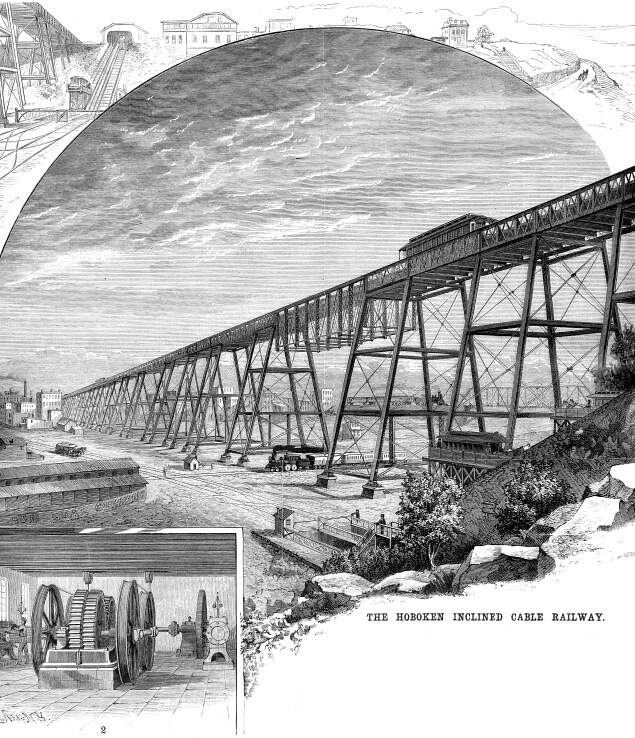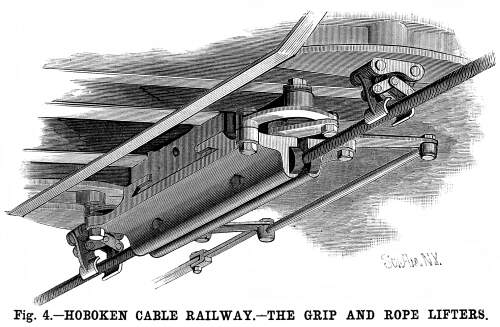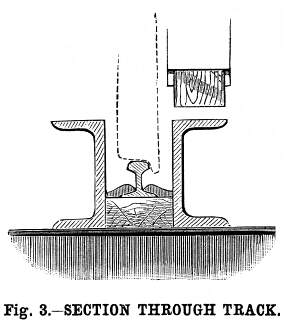THE HOBOKEN INCLINED CABLE
RAILWAY.
Scientific American—February 20, 1886
 The southern
end of the Palisades, with its steep and rugged sides, has always
presented a formidable obstacle in the path of the horse car railroads
of Jersey City and Hoboken. Steam railroads overcame the difficulty
by tunneling and open cuts, their main object being to pass the
hill; but the horse cars, having to mount the hill to accommodate
residents upon the Heights, were of course compelled to resort
to other means. Twenty years ago dummy engines were tried on the
routes leading from Hoboken ferry, but the grades proved to be
too steep, and they were abandoned. Horses, four to a car, were
again employed, and it took twenty minutes to reach the top of
the hill from the ferry, a distance of only one mile. In 1873,
the North Hudson County Railway Company concluded to construct
a short but steep inclined plane, and to elevate both cars and
horses by stationary steam power. A car and horses arriving at
the foot of the hill passed on to a large and substantial truck
and were drawn up the incline, 400 feet long and 100 hundred feet
high, in one minute. The southern
end of the Palisades, with its steep and rugged sides, has always
presented a formidable obstacle in the path of the horse car railroads
of Jersey City and Hoboken. Steam railroads overcame the difficulty
by tunneling and open cuts, their main object being to pass the
hill; but the horse cars, having to mount the hill to accommodate
residents upon the Heights, were of course compelled to resort
to other means. Twenty years ago dummy engines were tried on the
routes leading from Hoboken ferry, but the grades proved to be
too steep, and they were abandoned. Horses, four to a car, were
again employed, and it took twenty minutes to reach the top of
the hill from the ferry, a distance of only one mile. In 1873,
the North Hudson County Railway Company concluded to construct
a short but steep inclined plane, and to elevate both cars and
horses by stationary steam power. A car and horses arriving at
the foot of the hill passed on to a large and substantial truck
and were drawn up the incline, 400 feet long and 100 hundred feet
high, in one minute.
This was the first horse car elevator either in this country
or Europe. It has been in continuous operation ever since completion,
arid has never failed to work or caused an accident.
The truck, or elevator platform, is triangular in shape; the
hypotenuse is provided with four sets of wheels, which run up
a track extending up the incline, When at rest, the horizontal
side of the truck is on a level with the main track, either at
the bottom or top of the hill, and is of sufficient length to
receive a car and horses. There are two of these trucks, one upon
each track. Two wire ropes lead from each car around drums operated
by engines at the top of the hill, The cables are so arranged
that one truck passes up while the other is going down. A third
cable, attached to each truck and passing around sheaves at the
top of the hill, serves as a safeguard in case either set of hoisting
cables should break.
The travel increased to such an extent as to make necessary
the providing of additional facilities for mounting the hill.
It was therefore concluded to build the elevated railroad shown
in our frontispiece. This easily, accommodates all the travel,
and also shortens the time to the top of the hill from ten minutes
to five.
The most difficult task was to secure proper foundations for
the posts. Soundings made between the ferry and hill showed the
solid bottom to be from 20 to 90 feet below the meadow. At no
point could a firm foundation be secured without piling. The higher
part of the structure rests on towers 50 feet wide at the base
and 22 feet wide at the top. Each of the four corner posts is
set in heavy castings which rest on bluestone and brick piers
10 feet square at the bottom and 4 feet square at the top; these
piers are built upon cross timbers which hold together clusters
of 16 or 20 heavy piles. The foundations for the ordinary posts
on the level part of the structure are of a similar character,
but not so heavy, The structure is entirely of iron. The tracks
are of 67 pound steel rails, not laid on wooden cross ties, but
on white oak blocks, which are bolted to iron plates riveted in
between two iron channel bars, which, while adding strength to
the structure, also act as guardrails. This mode of laying the
track, dispensing with the wooden ties and substituting iron for
wooden guard rails, is far preferable to that of the elevated
roads of this city, as it is more durable, admits more light and
air, and looks better.
The structure starts from the ferry at an elevation of about
8 feet, and gradually rises until it reaches the first street,
where it is 15 feet high. It then continues level for about 3,500
feet, when it begins to rise at the rate of 5 feet in the hundred.
There are two curves in the road, one at the ferry and the other
at the foot of the steep grade.
The cable is of steel, 1½ inches in diameter, and the
total length is about 2½ miles. The motive power is situated
on top of the hill. There are four return-flue steel boilers,
each of 125 horse power. There are two Corliss engines, having
cylinders 30 inches in diameter and 5 feet stroke. The main shaft
is 15 inches thick. The engines are so arranged that they can
be used either singly or together. The flywheels are 20¾
feet in diameter, and each weighs 28 tons. The gearing for driving
the cable drums—shown in Fig. 2— similar to that illustrated
in our article describing the Tenth Avenue Cable Railway, of this
city, in the SCIENTIFIC AMERICAN
of January 30, 1886, and was built by Messrs. Poole & Hunt,
of Baltimore.
 The arrangement
and construction of the grips and rope lifters, Fig. 4, present
many advantages over the old methods. The grips are not fastened
to the body of the car, but to the wheel trucks, enabling the
car to pass easily around the curves, and causing the grip to
remain at the same distance from the cable, whether the car is
loaded or not. There is one grip on each of the two trucks of
the car. The grips are of iron, 3 feet long, and the cable is
in contact with the jaws of the grip for the entire 3 feet. The
grip is opened and closed by the turning of a hand wheel on the
platform. A worm gear and set of levers, forming a powerful and
positive movement, transmit the motion of the hand wheel to the
jaws of the grip. In front and in the rear of each grip are two
claws which can be opened and closed, lowered and raised, by means
of a lever on the platform to the left of the grip wheel, and
which enables the grip man to pick up the rope without the aid
of any other person, and at any place on the road, level or inclined,
at or between stations. The arrangement
and construction of the grips and rope lifters, Fig. 4, present
many advantages over the old methods. The grips are not fastened
to the body of the car, but to the wheel trucks, enabling the
car to pass easily around the curves, and causing the grip to
remain at the same distance from the cable, whether the car is
loaded or not. There is one grip on each of the two trucks of
the car. The grips are of iron, 3 feet long, and the cable is
in contact with the jaws of the grip for the entire 3 feet. The
grip is opened and closed by the turning of a hand wheel on the
platform. A worm gear and set of levers, forming a powerful and
positive movement, transmit the motion of the hand wheel to the
jaws of the grip. In front and in the rear of each grip are two
claws which can be opened and closed, lowered and raised, by means
of a lever on the platform to the left of the grip wheel, and
which enables the grip man to pick up the rope without the aid
of any other person, and at any place on the road, level or inclined,
at or between stations.
The cars have the ordinary brakes to check the wheels. These
brakes are tightened and loosened by the same wheel and worm gear
which tightens and loosens the grip. A movement of a lever to
the right of the hand wheel throws the brake into gear, and at
the same time the grip out of gear, and vice versa, making
it impossible to have the two forces (grip and brake power)  operating against one
another. In addition to the ordinary brakes, there are so-called
track brakes, to be used in case of emergency on the incline and
when the rails are slippery. Their shoes are about 2 feet long,
are surfaced with wood, and can be pressed down with much force
on the rough iron guard rails on each side of the track rails.
By their action the car can be stopped anywhere on the incline
or level, and in all kinds of weather. The construction of these
brakes will be understood from the cross-sectional view, Fig.
3. operating against one
another. In addition to the ordinary brakes, there are so-called
track brakes, to be used in case of emergency on the incline and
when the rails are slippery. Their shoes are about 2 feet long,
are surfaced with wood, and can be pressed down with much force
on the rough iron guard rails on each side of the track rails.
By their action the car can be stopped anywhere on the incline
or level, and in all kinds of weather. The construction of these
brakes will be understood from the cross-sectional view, Fig.
3.
The loading and unloading of passengers at the ferry is quickly
done, and without confusion. Near the terminus the down-track
runs by a switch into the up-track, so that only one track enters
the station. The down-cable continues, of course, in a straight
direction, and leaves the down-track; it passes to the end of
the station below the platform and around a large sheave, and
then returns on the up-track. The single track in the station
is flanked on each side by a wide platform. When a car arrives,
it comes in by momentum, having let go of the cable some 700 or
800 feet before reaching the station. The passengers pass out
of the car to the right and by the front door, and at the same
time passengers enter the car from the left and by the rear door.
Where the car stops to let out the passengers it remains until
it has taken in passengers again, and is ready to start. One minute
is sufficient to unload and load one car, or several if coupled
together. The up cable is right underneath the car; the grip man
lowers the rope lifter, raises the cable between the open jaws
of the grip, closes them gradually, and the car moves off.
The advantages of this system are apparent: The incoming and
outgoing passengers are completely separated from each other while
in the station; only space enough for the single track is taken
up within the station, thus leaving ample platform room at either
side; and as the loading and unloading go on simultaneously, no
time is lost. Possibly some such system could be applied to the
termini of the Brooklyn Bridge, where the shifting of cars from
track to track is now slowly performed by engines.
Stories Page | Contents Page
|







